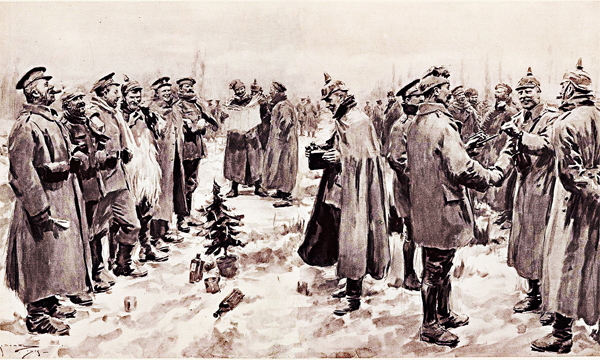
The World War I Christmas Truce on December 24-26, 1914
The World War I Christmas Truce: “Here we were laughing and chatting to men whom only a few hours before we were trying to kill!”
On Christmas Eve 1914, in the dank, muddy trenches on the Western Front of the first world war, a remarkable thing happened.
It came to be called the Christmas Truce. And it remains one of the most storied and strangest moments of the Great War - or of any war in history.
British machine gunner Bruce Bairnsfather, later a prominent cartoonist, wrote about it in his memoirs. Like most of his fellow infantrymen of the 1st Battalion of the Royal Warwickshire Regiment, he was spending the holiday eve shivering in the muck, trying to keep warm. He had spent a good part of the past few months fighting the Germans. And now, in a part of Belgium called Bois de Ploegsteert, he was crouched in a trench that stretched just three feet deep by three feet wide, his days and nights marked by an endless cycle of sleeplessness and fear, stale biscuits and cigarettes too wet to light.
“Here I was, in this horrible clay cavity”, Bairnsfather wrote, ”…miles and miles from home. Cold, wet through and covered with mud.” There didn’t “seem the slightest chance of leaving—except in an ambulance.”
Then the singing started
At about 10 p.m., Bairnsfather noticed a noise.
“I listened”, he recalled. “Away across the field, among the dark shadows beyond, I could hear the murmur of voices.” He turned to a fellow soldier in his trench and said, “Do you hear the Boches [Germans] kicking up that racket over there?”
“Yes”, came the reply. “They’ve been at it some time!”
The Germans were singing carols, as it was Christmas Eve. In the darkness, some of the British soldiers began to sing back.
“Suddenly”, Bairnsfather recalled, “we heard a confused shouting from the other side. We all stopped to listen. The shout came again.” The voice was from an enemy soldier, speaking in English with a strong German accent. He was saying, “Come over here.”
One of the British sergeants answered:
“You come half-way. I come half-way.”
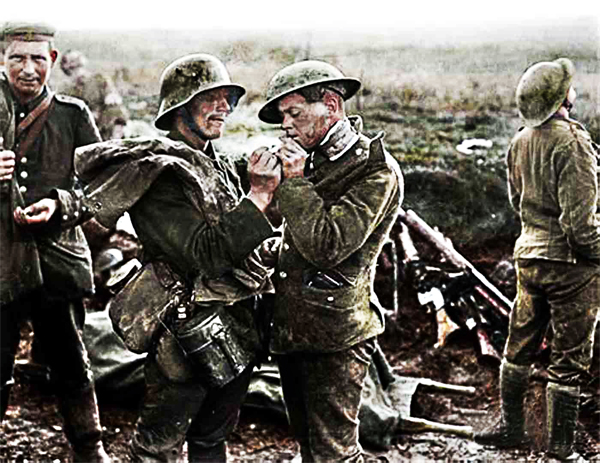
Continued ...
History Channel / Wikipedia / Encyclopedia Britannica /
Imperial War Museum (Great Britain) / The National Museum and Memorial.org / Mises Institute.org / Ohio History Connection.org /
Libertarian Institute.org / Smithsonian /
The World War I Christmas Truce on December 24-26, 1914 (YouTube) 
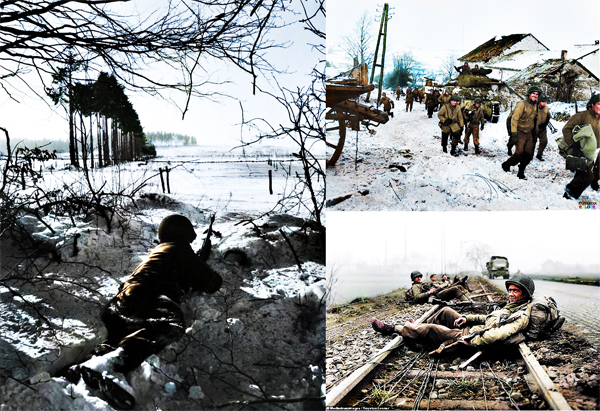
Battle of the Bulge begins on December 16, 1944
Battle of the Bulge begins: On December 16, 1944, the Germans launch the last major offensive of World War II, Operation Mist, also known as the Ardennes Offensive and the Battle of the Bulge, an attempt to push the Allied front line west from northern France to northwestern Belgium.
The Battle of the Bulge, so-called because the Germans created a “bulge” around the area of the Ardennes forest in pushing through the American defensive line, was the largest fought on the Western front.
The Germans threw 250,000 soldiers into the initial assault, 14 German infantry divisions guarded by five panzer divisions-against a mere 80,000 Americans. Their assault came in early morning at the weakest part of the Allied line, an 80-mile poorly protected stretch of hilly, woody forest (the Allies simply believed the Ardennes too difficult to traverse, and therefore an unlikely location for a German offensive). Between the vulnerability of the thin, isolated American units and the thick fog that prevented Allied air cover from discovering German movement, the Germans were able to push the Americans into retreat.
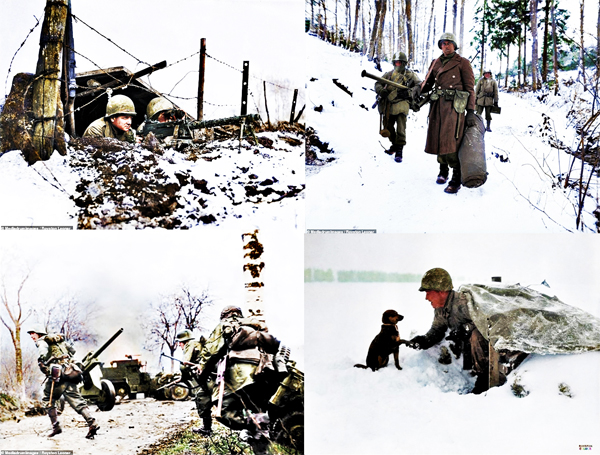
One particularly effective German trick was the use of English-speaking German commandos who infiltrated American lines and, using captured U.S. uniforms, trucks, and jeeps, impersonated U.S. military and sabotaged communications. The ploy caused widespread chaos and suspicion among the American troops as to the identity of fellow soldiers–even after the ruse was discovered. Even General Omar Bradley himself had to prove his identity three times–by answering questions about football and Betty Grable–before being allowed to pass a sentry point.
The battle raged for three weeks, resulting in a massive loss of American and civilian life. Nazi atrocities abounded, including the murder of 72 American soldiers by SS soldiers in the Ardennes town of Malmedy. Historian Stephen Ambrose estimated that by war’s end, “Of the 600,000 GIs involved, almost 20,000 were killed, another 20,000 were captured, and 40,000 were wounded.”
The United States also suffered its second-largest surrender of troops of the war: More than 7,500 members of the 106th Infantry Division capitulated at one time at Schnee Eifel. The devastating ferocity of the conflict also made desertion an issue for the American troops; General Eisenhower was forced to make an example of Private Eddie Slovik, the first American executed for desertion since the American Civil War.
The war would not end until better weather enabled American aircraft to bomb and strafe German positions.
History Channel / Wikipedia / Encyclopedia Britannica /
ARMY.mil / The National WW2 Museum.org / Imperial War Museum (Great Britain) / United States Memorial Holocaust Encyclopedia USHMM.org / Library Of Congress.gov /
Battle of the Bulge begins on December 16, 1944 (YouTube) 
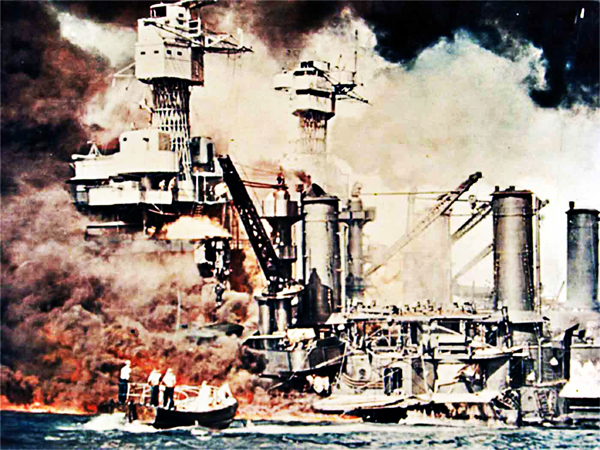
Pearl Harbor bombed on December 7, 1941
Pearl Harbor bombed At 7:55 a.m. Hawaii time, a Japanese dive bomber bearing the red symbol of the Rising Sun of Japan on its wings appears out of the clouds above the island of Oahu. A swarm of 360 Japanese warplanes followed, descending on the U.S. naval base at Pearl Harbor in a ferocious assault. The surprise attack struck a critical blow against the U.S. Pacific fleet and drew the United States irrevocably into World War II.
With diplomatic negotiations with Japan breaking down, President Franklin D. Roosevelt and his advisers knew that an imminent Japanese attack was probable, but nothing had been done to increase security at the important naval base at Pearl Harbor. It was Sunday morning, and many military personnel had been given passes to attend religious services off base. At 7:02 a.m., two radar operators spotted large groups of aircraft in flight toward the island from the north, but, with a flight of B-17s expected from the United States at the time, they were told to sound no alarm. Thus, the Japanese air assault came as a devastating surprise to the naval base.
Much of the Pacific fleet was rendered useless: Five of eight battleships, three destroyers, and seven other ships were sunk or severely damaged, and more than 200 aircraft were destroyed. A total of 2,400 Americans were killed and 1,200 were wounded, many while valiantly attempting to repulse the attack. Japan’s losses were some 30 planes, five midget submarines, and fewer than 100 men. Fortunately for the United States, all three Pacific fleet carriers were out at sea on training maneuvers. These giant aircraft carriers would have their revenge against Japan six months later at the Battle of Midway, reversing the tide against the previously invincible Japanese navy in a spectacular victory.
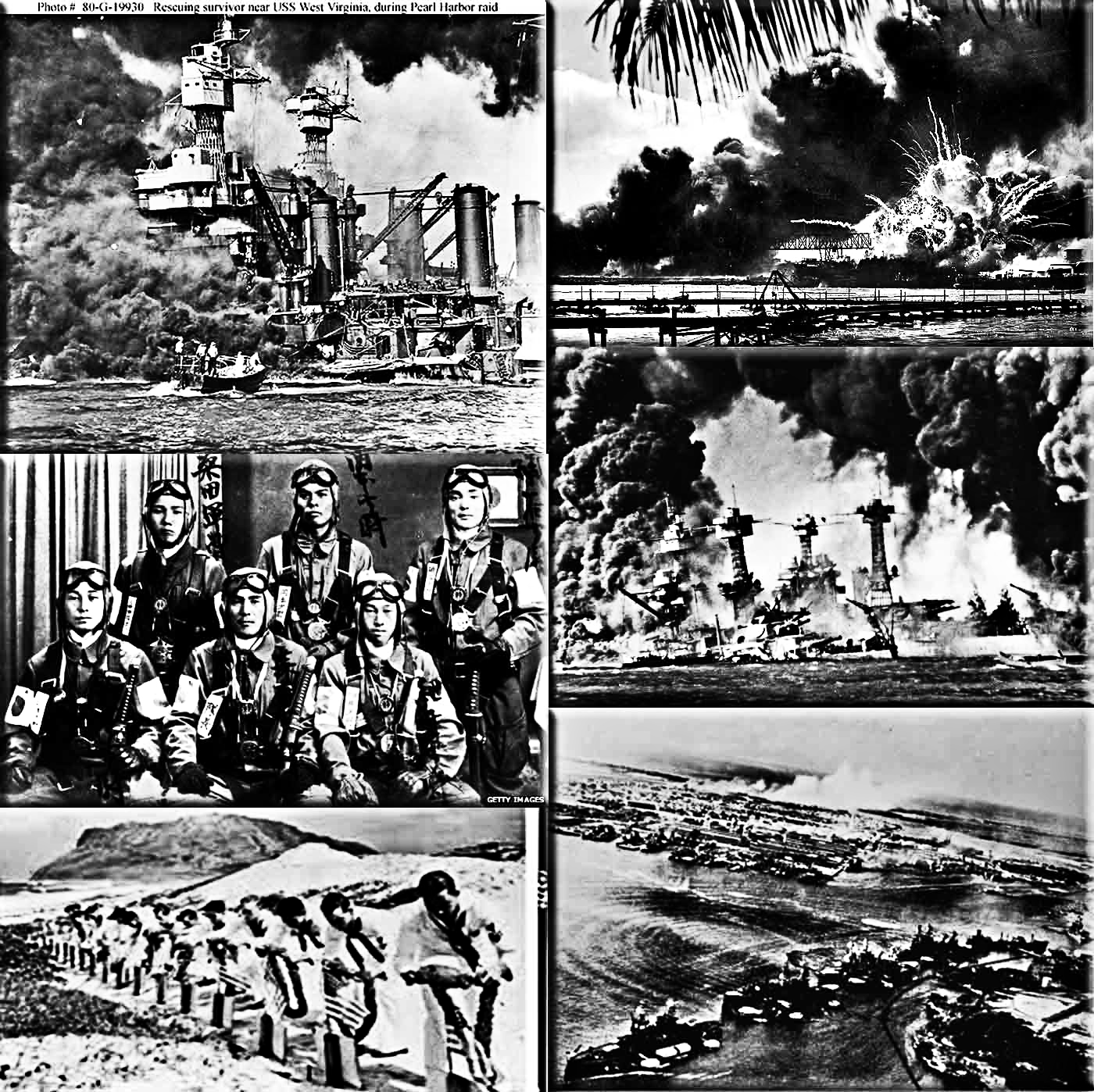
The day after Pearl Harbor was bombed, President Roosevelt appeared before a joint session of Congress and declared, “Yesterday, December 7, 1941–a date which will live in infamy–the United States of America was suddenly and deliberately attacked by naval and air forces of the Empire of Japan.”
After a brief and forceful speech, he asked Congress to approve a resolution recognizing the state of war between the United States and Japan. The Senate voted for war against Japan by 82 to 0, and the House of Representatives approved the resolution by a vote of 388 to 1. The sole dissenter was Representative Jeannette Rankin of Montana, a devout pacifist who had also cast a dissenting vote against the U.S. entrance into World War I. Three days later, Germany and Italy declared war against the United States, and the U.S. government responded in kind.
The American contribution to the successful Allied war effort spanned four long years and cost more than 400,000 American lives.
History Channel / Wikipedia / Encyclopedia Britannica / Pearl Harbor Oahu / National Park Service
/ Pearl Harbor - Dec. 7, 1941 - The only color film of the attack (YouTube)” 
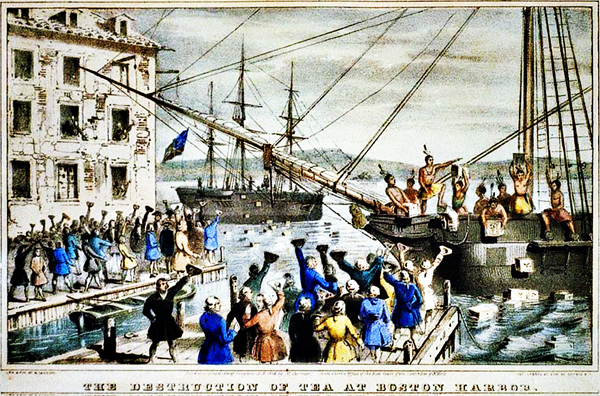
The Boston Tea Party on December 16, 1773
The Boston Tea Party: In Boston Harbor, a group of Massachusetts colonists disguised as Mohawk Indians board three British tea ships and dump 342 chests of tea into the harbor.
The midnight raid, popularly known as the “Boston Tea Party”, was in protest of the British Parliament’s Tea Act of 1773, a bill designed to save the faltering East India Company by greatly lowering its tea tax and granting it a virtual monopoly on the American tea trade. The low tax allowed the East India Company to undercut even tea smuggled into America by Dutch traders, and many colonists viewed the act as another example of taxation tyranny.
When three tea ships, the Dartmouth, the Eleanor, and the Beaver, arrived in Boston Harbor, the colonists demanded that the tea be returned to England. After Massachusetts Governor Thomas Hutchinson refused, Patriot leader Samuel Adams organized the “tea party” with about 60 members of the Sons of Liberty, his underground resistance group. The British tea dumped in Boston Harbor on the night of December 16 was valued at some $18,000.
Parliament, outraged by the blatant destruction of British property, enacted the Coercive Acts, also known as the Intolerable Acts, in 1774. The Coercive Acts closed Boston to merchant shipping, established formal British military rule in Massachusetts, made British officials immune to criminal prosecution in America, and required colonists to quarter British troops. The colonists subsequently called the first Continental Congress to consider a united American resistance to the British.
History Channel / Wikipedia / Encyclopedia Britannica /
Constitution Center.org / Boston Tea Partyship / Massachusetts Historical Society /
The Boston Tea Party on December 16, 1773 (YouTube) 
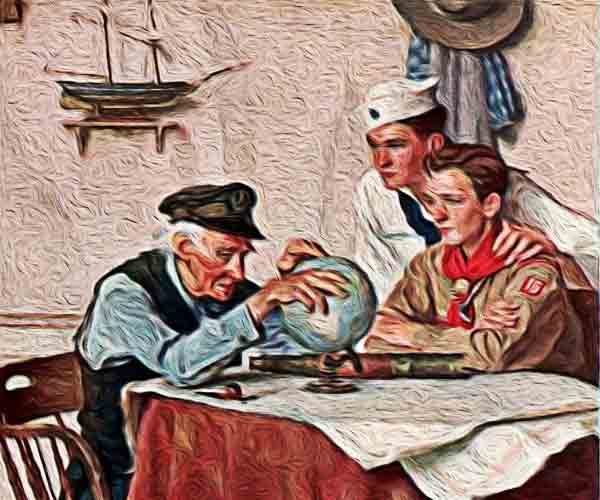
Understanding Military Terminology
Repairable Item
(DOD) Unit equipment left by deploying forces at their bases when they deploy.
Joint Publications (JP 4-09) Distribution Operations
Repair Cycle
(DOD) The stages through which a repairable item passes from the time of its removal or replacement until it is reinstalled or placed in stock in a serviceable condition.
Joint Publications (JP 4-09) Distribution Operations
Repatriation
(DOD) 1. The procedure whereby American citizens and their families are officiall back into the United States subsequent to an evacuation. See also evacuation.
Joint Publications (JP 3-68) Distribution Operations
(DOD) 2. The release and return of enemy prisoners of war to their own country in accordance with the 1949 Geneva Convention Relative to the Treatment of Prisoners of War.
Joint Publications (P 1-0) Doctrine for the Armed Forces of the United States
Joint Publication - Department of Defense Dictionary of Military and Associated Terms
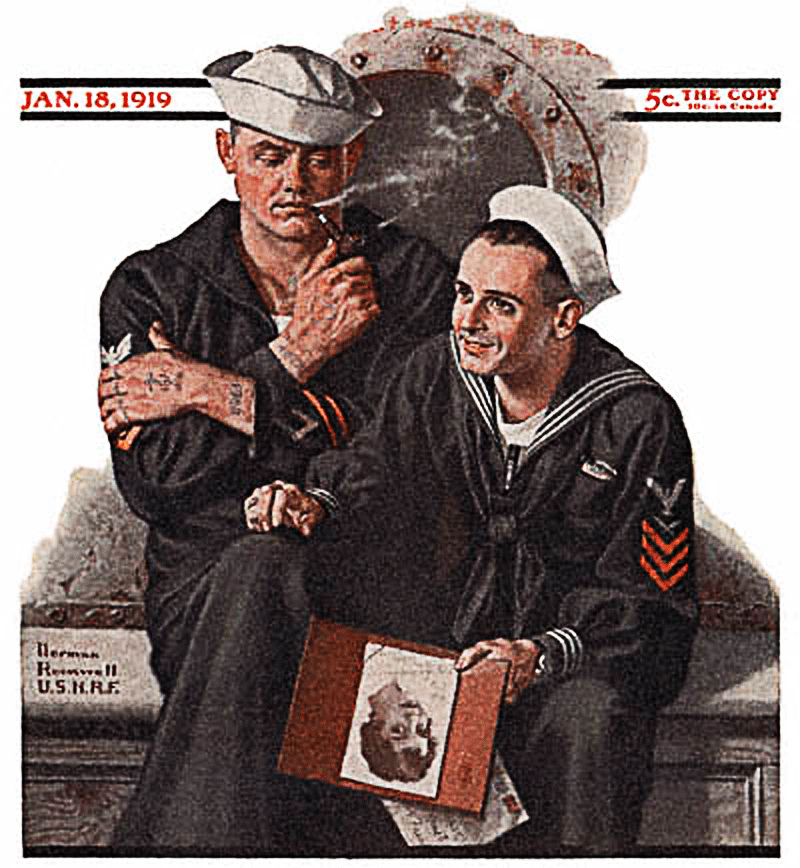
The Old Salt’s Corner

“A SUBMARINE CHRISTMAS POEM”
T'was the night before Christmas, he lived in a crowd,
In a 40 man berthing, with shipmates snoring so loud.
I had come down the Sail with presents to give,
And to see just who in this rack did live.
I looked all about, a strange sight did I see,
No tinsel, no presents, not even a tree.
No stockings were hung, just a “poopy suit” close at hand,
On the bulkhead hung pictures of a far distant land.
He had medals and badges and awards from far and wide,
But one in particular my eye did soon find.
Why, they were Dolphins, with a tiny submarine...pinned on with pride,
Then a sobering thought did come to my mind.
For this place was different, it was so dark and dreary,
I had found the home of a Sub Sailor, once I could see clearly.
The Sailor lay sleeping, silent and alone,
Curled up in his rack, dreaming of home.
The face was so gentle, the berthing in good order,
Not how I pictured a U. S. Submarine Sailor.
Was this the hero whom I saw on TV?
Defending his country so we all could be free?
I realized the families that I've seen this cold night,
Owed their lives to these Sailors who were willing to fight.
“You've got high dust and low dust, and that overhead it needs cleaning!”
Soon, 'round the world the children would play,
And grownups would celebrate a new Christmas Day.
They all enjoyed freedom each day of the year
Because of these Sailors, like the one lying here.
I couldn't help but wonder how many lay alone,
On a cold Christmas Eve, under sea, far from home.
\
The very thought made me pause and brought a tear to my eye,
I dropped to my knees and started to cry.
The Sailor awakened and I heard a gruff voice
“Santa, don't cry for me; this life is my choice.
I'll defend the seas on this day
Then on re-inspection he explained with a huff,
And let others rejoice.”
The Sailor rolled over and drifted to sleep,
I couldn't control it, I started to weep.
I kept watch then for hours, silent and still,
And we both shivered a bit from the night's aching chill.
It seemed like eternity until reveille sounded
I didn't want to leave, on that dreary, cold night,
This Guardian of Honor, so willing to fight.
Then the Sailor rolled over and with a voice soft and pure,
Whispered, “Carry on, Santa, it's Christmas Day... all's secure.”
~ Unknown

“I’m Just Sayin”
“Every exit is an entry somewhere else.”
“Good things, when short, are twice as good.”
“My whole life is waiting for the questions to which I have prepared answers.”
“Responsibilities gravitate to the person who can shoulder them.”
“We give advice by the bucket, but take it by the grain.”
“If you carry your childhood with you,
you never become older.”
“A healthy attitude is contagious but
don't wait to catch it from others.
Be a carrier.”
“Life is a gamble,
at terrible odds -
if it was a bet you wouldn't take it.”
“We cross our bridges when we come to them and burn them behind us,
with nothing to show for our progress except a memory of the smell of smoke
and a presumption that once our eyes watered.”
~ Tom Stoppard

“Thought for the Day”
“Courage is fear holding on a minute longer.
“The object of war is not to die for your country but to make the other bastard die for his.”
“A pint of sweat, saves a gallon of blood.”
“If everyone is thinking alike, then somebody isn't thinking.”
“Untutored courage is useless in the face of educated bullets.”
“Prepare for the unknown by studying how others in the past have coped with the unforeseeable and the unpredictable.”
“It is foolish and wrong to mourn the men who died.
Rather we should thank God that such men lived.”
“There is a time to take counsel of your fears,
and there is a time to never listen to any fear.”
“Watch what people are cynical about,
and one can often discover what they lack.”
“Nobody ever defended anything successfully,
there is only attack and attack and attack some more.”
~ George S. Patton

“What I Learned”
“The shortest distance between two points is a straight line.”
“Give me a lever long enough and a fulcrum on which to place it,
and I shall move the world.”
“Eureka! -
I have found it!”
~ Archimedes
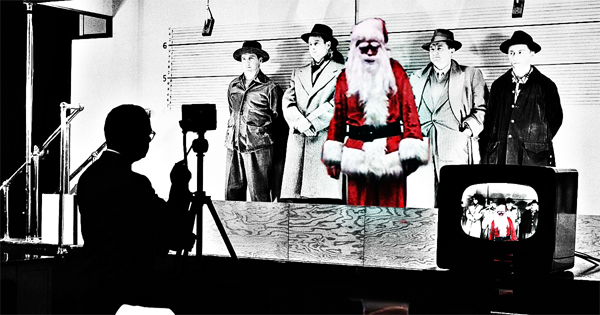
Mr. Answer Man Please Tell Us: Santa Claus Bank Robbery on December 23, 1927
Santa Claus Bank Robbery: At the time it occurred, the Santa Claus Bank Robbery was one of Texas' most infamous crimes and led to the largest manhunt ever seen in the state. It all began on December 23, 1927, around noon when Marshall Ratliff, Henry Helms, Robert Hill, all ex-cons, and Louis Davis, a relative of Helms, held up the First National Bank in Cisco.
Ratliff had been caught with his brother Lee after robbing a bank in Valera, and they had each served only a year of their sentences before being pardoned by Governor Miriam A. Ferguson. They had planned to rob the Cisco bank together, but Lee had already been arrested again.
So Marshall pulled in Helms and Hill, whom he knew from Huntsville, and a fourth man who was good with safes. As they planned the crime in Wichita Falls, the safe-cracker came down with the flu, and the trio pulled in Davis, a family man in need, with the offer of big money.
The four stole a car in Wichita Falls and headed for Cisco. They arrived on the morning of December 23 and prepared to make themselves some easy money, or so they thought.
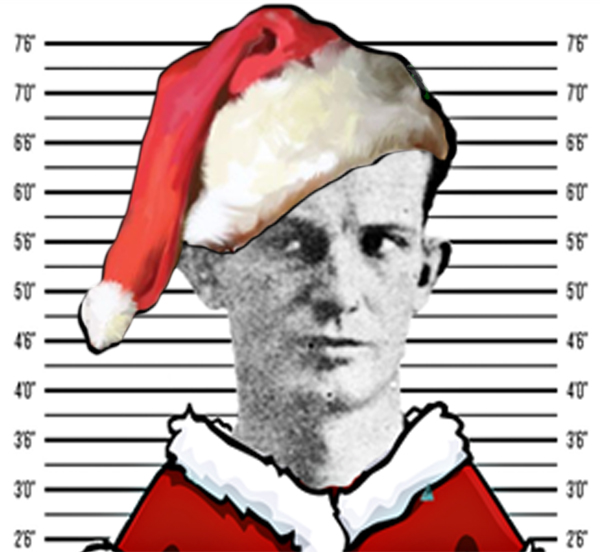
During this period three or four Texas banks a day were being robbed, and in response, the Texas Bankers Association had offered a $5,000 reward to anyone shooting a bank robber during the crime. It was partly this reward that turned a simple bank robbery into a deadly crime.
As the group neared the bank, Ratliff donned a Santa Claus suit he had borrowed from Mrs. Midge Tellet, who ran the boarding house where they had been staying in Wichita Falls. They let Ratliff out several blocks from the bank.
Followed by children attracted to “Santa”, Ratliff joined the other three in an alley and led the way into the bank.
Continued ...
Texas State Historical Association
• The Texan
• Mental Floss
• Wikipedia
• Santa Claus Bank Robbery on December 23, 1927 (YouTube Search) 
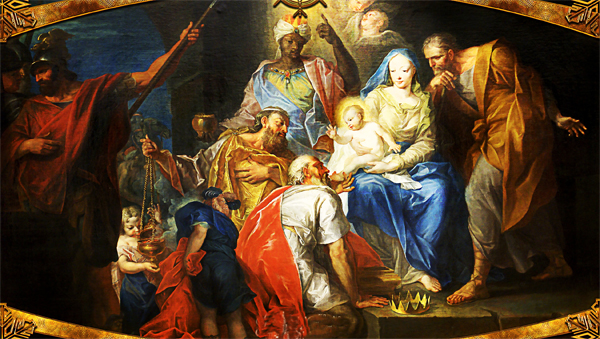
Mr. Answer Man Please Tell Us: The Origins of Christmas
Christmas is both a sacred religious holiday and a worldwide cultural and commercial phenomenon. For two millennia, people around the world have been observing it with traditions and practices that are both religious and secular in nature. Christians celebrate Christmas Day as the anniversary of the birth of Jesus of Nazareth, a spiritual leader whose teachings form the basis of their religion. Popular customs include exchanging gifts, decorating Christmas trees, attending church, sharing meals with family and friends and, of course, waiting for Santa Claus to arrive. December 25 - Christmas Day - has been a federal holiday in the United States since 1870.
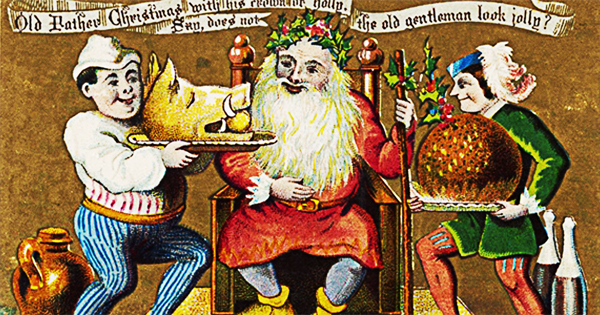
An Ancient Holiday
The middle of winter has long been a time of celebration around the world. Centuries before the arrival of the man called Jesus, early Europeans celebrated light and birth in the darkest days of winter. Many peoples rejoiced during the winter solstice, when the worst of the winter was behind them and they could look forward to longer days and extended hours of sunlight.
In Scandinavia, the Norse celebrated Yule from December 21, the winter solstice, through January. In recognition of the return of the sun, fathers and sons would bring home large logs, which they would set on fire. The people would feast until the log burned out, which could take as many as 12 days. The Norse believed that each spark from the fire represented a new pig or calf that would be born during the coming year.
The end of December was a perfect time for celebration in most areas of Europe. At that time of year, most cattle were slaughtered so they would not have to be fed during the winter. For many, it was the only time of year when they had a supply of fresh meat. In addition, most wine and beer made during the year was finally fermented and ready for drinking.
In Germany, people honored the pagan god Oden during the mid-winter holiday. Germans were terrified of Oden, as they believed he made nocturnal flights through the sky to observe his people, and then decide who would prosper or perish. Because of his presence, many people chose to stay inside.
Continued ...
History Channel / Wikipedia / Encyclopedia Britannica /
History Cooperative.org / Got Questions.org / Live Science / Mental Floss / Quora /
The Origins of Christmas (YouTube) 

NAVSPEAK aka U.S. Navy Slang
Wolf Ticket: Highly suspect information. Can refer to malicious “scuttlebutt”, exaggerated “no-shitters”, or blatently phony sea stories.
Woop: A cadet at the U.S. Military Academy (West Point).
Workups: 1- to 6-week periods preceding a deployment during which the ship and/or its airwing practice and prepare.
Widely known workups involving the carrier and the airwing are TSTA, COMPTUEX, and RIMPAC.
Airwing only workups include trips to NAS Fallon and NAS Key West.
Wrinkle Bomb: A uniform worn by a sailor that is wrinkled so badly that it looks like the sailor slept in it. See “Raisin”.
“Wrong answer, RPOC!”: What Company Commanders in boot camp would scream at the RPOC when he/unit screwed up. Immediately followed by, “Push up, position, Shitbags!” Example:
“WHY THE FUCK DID YOU LET THEM MARCH BACK FROM CHOW?!?”
“I thought you wanted us back early for the inspection, Sir!”
”Wrong answer, RPOC!”;
WTF (pronounced “Whiskey Tango Foxtrot” using the phonetic alphabet): “What the Fuck?” What just happened? Can also be in written form WTF K (with a line over the K) meaning “WTF Over”
Weaponette (Submarine Service): A member of a submarine's Weapons Department (used by members of the Navigation/Operations Department or Engineering Department, usually when they want their stolen tools back).
Wog: Short for “pollywog”, as in “wog ceremony”.
Wog Dog: Sailor acting as a vicious dog and part of the “Royal Party” during Shellback initiation.
Word Shitter: Another name for those embossing label makers. They “shit” words out when one squeezes the handle.
Working Party: When there is loading of supplies, the Quarterdeck will call for a “working party” to be manned by each division of the ship, the number depending on the task.
Would you like a kick to help you get airborne?: Seen on a numerical list of epithet substitutions, especially transmitted over radio, which has to stay clean.
W.U.N.A.: World´s Ugliest Naval Aviator.
Wiktionary.org

Just for you MARINE
Wing Wiper: Aviation person, usually a maintenance person and not a pilot.
WIR: DRMO; Washed-out In Repair; waste incidental to reprocessing; collection of items or equipment for turn-in that may be re-used by someone else at a later time, preferably at a savings to the government.
The Wire: Defensive perimeter of a firm base, crossing it denotes the end of relative safety.
Wook: A female marine.
Wooly Pully: reen wool sweater worn with the service uniform (or blue with the dress uniform) over the khaki shirt.
Word: General term for instructions, orders, and information that is required for all members of a unit to know; or the act of passing information to a collected group of servicemembers. See also gouge.
WM: AUnofficial acronym that stands for a Woman Marine. Generally considered to be pejorative.
Work your Bolt: Resort to special measures, either by energy or guile, in order to attain a particular end; from the action of racking a rifle's bolt to clear a stoppage.
Wikipedia.org

Naval Aviation Squadron Nicknames
U.S. Carrier Airborne Early Warning Weapons School Naval Aviation Squadron Nicknames: “TOPDOME”
United States Navy - Naval Air Station Fallon - Near Fallon, Nevada
Wikipedia.org

Where Did That Saying Come From?

“Attack is the best form of defence:”
Meaning: The proverbial phrase 'attack is the best form of defence' expresses the opinion that a pre-emptive strike is the best way to defend yourself.
The proverb was coined with military attack in mind but it is now used more widely, in sports and in everyday life.
In the USA the proverb is usually expressed as 'the best defense is a good offense'.
Origin: 'Attack is the best form of defence' was coined in the USA in the 18th century. It was initially intended to be a military tactic rather than an everyday maxim.
The earliest version of it that I know of is in R. W. Gibbes' Documentary History of the American Revolution, in which he attributes this comment to a W. H. Drayton and dates it as 1775:
“It is a maxim, that it is better to attack than to receive one.”
George Washington also expressed the same view in 1799, as is recorded in his Writings, published in 1940:
“Make them believe, that offensive operations, often times, is the surest, if not the only (in some cases) means of defence.”
Although this proverb is American it crossed the Atlantic and became established in the UK. It is still used there in the original 'attack is the best form of defence' form.
In the USA the wording has migrated and is now more commonly expressed there as 'the best defense is a good offense'.
[Note the spelling - typically in the UK 'defence'; in the USA 'defense'.
This began being used, in sporting contexts, in the early 20th century. The earliest example that I can find is in the Virginia newspaper The Times Dispatch, February 1911:
He believes firmly in the doctrine of “Hurry-Up” Yost [a.k.a. football coach Fielding Harris Yost] of Michigan, that “the best defense is a good offense.”
Phrases.org UK

Science & Technology

Feature: Time crystals “impossible” but obey quantum physics
• “Fruitcake” structure observed in organic polymers
Study suggests that most of our evolutionary trees could be wrong
• How electric fish were able to evolve electric organs
• The surprising musical dynamics of a lava lake on Kīlauea volcano
Bacteria-killing nano-drills get an upgrade: Visible light triggers molecular machines to treat infections
• A marsupial robotic system that combines a legged and an aerial robot
• Novel genetic experiment shrinks tough-to-treat cancer
Researchers ID gene critical to human immune response
• Brain cell activity plays critical role in central nervous system disorder outcomes
• Astronomy team finds evidence of galactic metal shrouded in dust
Phys.org / MedicalXpress / TechXplore

FEATURED: Sensory system fluid dynamics in miniature frog
• What causes Long Covid? Here are the three leading theories
News at a glance: Webb telescope dinged, U.S.-Russia research paused, and NASA’s UFO study
• Newly identified population of polar bears survives on glacier slush, not sea ice
Record-shattering events spur advances in tying climate change to extreme weathere
• Murders of women worldwide remain vastly undercounted. Activists are now filling in the gaps
Arkansas scientist gets 1-year sentence in case stemming from China Initiative
• Disgraced Italian surgeon convicted of criminal harm to stem cell patient
Science AAAS

Bizarre News (we couldn’t make up stuff this good - real news story)
How this trippy illusion will make you see an “expanding black hole”

Is it for ethical reasons or are there technological barriers?
A brand new optical illusion tricks the majority of people into thinking that a dark “black hole” region at the center of a stationary image is rapidly expanding, as if the observer were moving toward it. Researchers now suspect that the image literally tricks the brain into thinking that the observer is moving into a darkened space, like a cave or tunnel.
The illusion consists of a large black ellipse surrounded by a dark halo on a white background filled with smaller black ellipses. Typically, as a person stares at the image, the dark elliptical region will appear to expand outward for a couple of seconds, which is why the design has been nicknamed the “expanding hole”.
In a new study, researchers found that 86% of the 50 participants who looked at the optical illusion reported seeing the expanding darkness. The team suspects that the illusion plays on the brain's perception of changing light levels.
“The expanding hole is a highly dynamic illusion”, lead researcher Bruno Laeng, a psychologist at the University of Oslo in Norway, said in a statement. The illusion tricks the mind into seeing a change in brightness that isn't really there, “as if the observer were heading forward into a hole or tunnel”, Laeng added.

The illusion hijacks a natural reaction in the brain that predicts when light is about to change, the researchers said. The dark region at the center of the image mimics the entrance to a cave or tunnel, and the surrounding pattern gives the observer the impression that they are moving toward that cave or tunnel. When the brain registers a potential change in light intensity, such as walking into a cave, it can trigger the pupils to contract or dilate to prepare you for the upcoming disruption in advance.
The illusion is so good at tricking the brain that it also causes people's pupils to dilate as if they were actually moving into a darker space. The researchers used special cameras to track observers' eye movements as they looked at the illusion, and the scientists found that their subjects' pupils were expanding just like the dark region of the illusion appeared to expand in their minds. Those who saw a bigger dark hole showed more dilation than those who saw a less-stark “black hole”, the researchers said.
“The illusion of the expanding hole prompts a corresponding dilation of the pupil, as it would happen if darkness really increased”, Laeng said. This shows that “the pupil reacts to how we perceive light, even if this light is imaginary.”
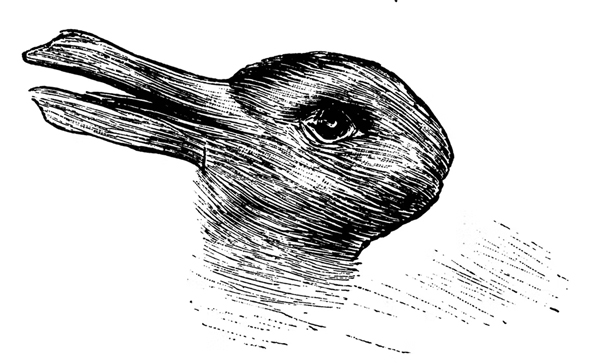
The researchers also exposed observers to versions of the illusions where the color of the ellipses had been changed. When this happened, the illusion's expanding effect was reduced and the observer's pupil dilations were less noticeable. And when the colors were inverted (placing white ellipses on a black background), the observers' pupils contracted, instead of expanding, as if they were moving toward a bright light.
The researchers have no idea why some people who look at the expanding hole are unable to see the dark region moving. The team hopes to test the illusion on other animals and see if they can learn more about how those visual systems differ from that in humans, to solve this mystery.
The new study was published online May 30 in the journal Frontiers in Human Neuroscience (opens in new tab).
Related: A new type of optical illusion tricks the brain into seeing dazzling rays
Live Science (04/25/2022) 


SONG FACTS
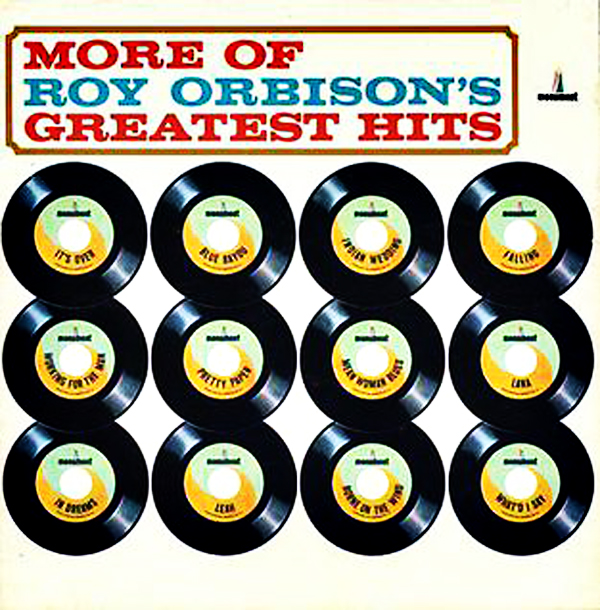
“(Oh) Pretty Woman” - Roy Orbison
Album: Roy Orbison - Greatest Hits
Released 1964 
Roy Orbison was writing with his songwriting partner Bill Dees at his house when he told Dees to get started writing by playing anything that came to mind. Orbison's wife Claudette came in and said she was going to go into town to buy something. Orbison asked if she needed any money, and Dees cracked, ”Pretty woman never needs any money”. Inspired, Orbison started singing,
“(Oh) Pretty Woman”  .
.
Bill Dees recalls in 1000 UK #1 Hits by Jon Kutner and Spencer Leigh:
“He sang it while I was banging my hand down on the table and by the time she returned we had the song. I love the song. From the moment that the rhythm started, I could hear the heels clicking on the pavement, click, click, the pretty woman walking down the street, in a yellow skirt and red shoes. We wrote Oh Pretty Woman on a Friday, the next Friday we recorded it, and the next Friday it was out. It was the fastest thing I ever saw. Actually, the “yeah, yeah, yeah” in “Oh Pretty Woman” probably came from The Beatles.”
In the same book Bill Dees recounts how the distinctive growling cry of “Mercy” came about:
“I can't do that growl like Roy, but the “Mercy” is mine. I used to say that all the time when I saw a pretty woman or had some good food. Still do.”
Orbison and his wife Claudette had recently reconciled after some tough times, but as this song was climbing the charts, Roy found out she had been cheating on him and filed for divorce. In 1966, they remarried, but two months later Claudette was killed when the motorcycle she was riding was hit by a truck. Orbison faced tragedy again when his two oldest sons died in a fire at his home in 1968. He was on tour at the time.
This was Orbison's last big hit. His career faded fast, but was revived in the '80s when prominent musicians like Bruce Springsteen, Bob Dylan and George Harrison cited him as an influence and invited him to join various projects.
He was inducted to the Rock and Roll Hall of Fame and joined The Traveling Wilburys with Dylan, Tom Petty, Harrison and Jeff Lynne. As he was enjoying this career revival, he died of a heart attack on December 6, 1988 at age 52.
With his dark sunglasses and plaintive voice, Orbison gave the impression that he was always longing and sometimes miserable, which was not the case. Speaking with the NME in 1980, he explained what's going on in this song:
“There's a ballad in the mid-section of it there: he's very sure of getting the girl when he first sees her, and then he's not so sure, and then he gets desperate, and then he says forget it, and then she comes back.”
“It's quite complicated, but it's probably in the presentation, or if I'm really singing like I know I can and I'm doing the job that I should be doing, then it could be that the voice quality in parts has a melancholy something.”
In 1989, the controversial rap group 2 Live Crew recorded a parody of this song, using the alternate title
“Pretty Woman”  .
for their album “Clean As They Wanna Be”.
The Crew sampled the distinctive bassline, but the romantic lyrics were replaced by talk about a hairy woman and her bald-headed friend.
.
for their album “Clean As They Wanna Be”.
The Crew sampled the distinctive bassline, but the romantic lyrics were replaced by talk about a hairy woman and her bald-headed friend.
Orbison's publisher, Acuff-Rose Music, sued 2 Live Crew on the basis that the fair use doctrine did not permit reuse of their copyrighted material for profit. The case, Campbell vs. Acuff-Rose Music, went all the way to the U.S. Supreme Court. On March 7 1994, the Court ruled that 2 Live Crew's parody did not violate federal copyright laws, clarifying that parody constitutes fair use under certain circumstances. A key to the decision is the judgment that 2 Live Crew did not harm the market value of Orbison's original with their parody - in other words, nobody was rejecting
“(Oh) Pretty Woman” because they could get the 2 Live Crew song instead.
To this point, parody artists either took great care to avoid using copyrighted songs (by writing original backing music or sticking with songs in the public domain) or got permission from the publishers before doing their parodies. “Weird” Al Yankovic, who had been doing parodies for 15 years by this point, always got permission from publishers when needed, and even asked the artists if they were OK with his send-ups before releasing them.
This was used in the 1990 movie of the same name starring Julia Roberts and Richard Gere. When the film was shot, its working title was 3000; the song was added later and became the title.
Other movies that have used this song include Dumb and Dumber (1994) and Au Pair (1999).
In 1964, Orbison was the only American artist to have a #1 UK hit, and he did it twice - with
“(Oh) Pretty Woman”  and
“It's Over”
and
“It's Over”  .
.
Orbison won a posthumous Grammy Award for Best Male Pop Vocal Performance in 1991 for a live version featured in the 1988 TV special Roy Orbison And Friends: A Black And White Night.
Continued ...
MORE SONGS
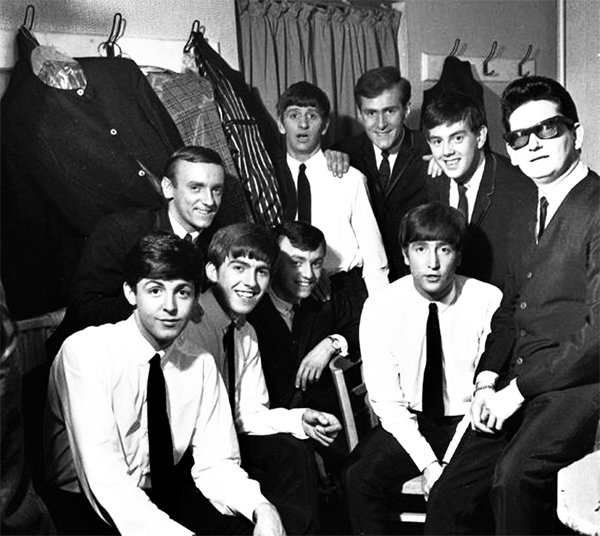
1956
“Ooby Dooby”  Video
Video 
1960
“Only The Lonely (Know The Way I Feel)”  Video
Video  Live
Live 
“Blue Angel”  Video
Video  Live
Live 
1961
“Crying”  Video
Video  Live
Live 
“Candy Man”  Video
Video  Live
Live 
“Running Scared”  Video
Video  Live
Live 
1962
“Dream Baby (How Long Must I Dream)”  Video
Video  Live
Live 
“Leah”  Video
Video  Live
Live 
1963
“In Dreams”  Video
Video  Live
Live 
“Blue Bayou”  Video
Video  Live
Live 
1964
“(Oh) Pretty Woman”  Video
Video  Live
Live 
“It's Over”  Video
Video  Live
Live 
1968
“Walk On”  Video
Video  Live
Live 
1969
“Penny Arcade”  Video
Video  Live
Live 
1972
“Danny Boy”  Live
Live 
1989
“You Got It”  Video
Video  Live
Live 
“California Blue”  Video
Video  Live
Live 
“I Drove All Night”  Video
Video  Live
Live 
“A Love so Beautiful”  Video
Video  Live
Live 
“She's a Mystery to Me”  Video
Video  Live
Live 
“(Oh) Pretty Woman” - Roy Orbison 1964 Continued ...
Roy Orbison, official website (Roy Orbison Discography) / Rock & Roll Hall of Fame / Billboard / All Music / Song Facts /
Ultimate Classic Rock / Roy Orbison
Image: “Roy Orbison - Greatest Hits (Album)” by Roy Orbison

Trivia
Eight (no Rudolph!) reindeer are featured in the poem “Twas the Night Before Christmas?”
A Charlie Brown Christmas: In dictating a letter to Santa, Sally ultimately asks Santa for one gift - “Just send money. How about tens and twenties?”.
In the early 1800s, the first gingerbread houses were reportedly inspired by the famous fairy tale “Hansel and Gretel”.
Coca-Cola has been using Santa Claus in its advertising since 1931.
The Nutcracker a Christmas-themed ballet premiered in Saint Petersburg, Russia in 1892.
The Christmas edible Fruitcake is known for its long shelf life.
● What Christian group banned Christmas in Boston from 1659 to 1681?
Answer to Trivia
● Before becoming associated with Christmas what was Yule?
Answer to Trivia
● What Roman holiday held from December 17th to the 23rd had a large influence on how Christmas was celebrated?
Answer to Trivia
● Among Christians who lived in the East, when was Christmas originally celebrated?
Answer to Trivia
● In what century was the first written use of Xmas?
Answer to Trivia
● The modern Santa Claus is mainly a mix of what two figures?
Answer to Trivia
● What political cartoonist is largely responsible for defining what the modern Santa Claus looks like?
Answer to Trivia

A Test for People Who Know Everything
From the Jeopardy Archives Category - “TO DONUTS” ($200)
“‘The Donut’ by Michael Krondl says the treat became popular with this profession back when all-night food options were few.”
Answer to Jeopardy READ MORE: MichaelHrondl.net
From the Jeopardy Archives Category - “TO DONUTS” ($400)
“Milk & powdered sugar are Mark Bittman's 2 ingredients for this 5-letter substance that covers many a Krispy Kreme donut.”
Answer to Jeopardy READ MORE: MichaelHrondl.net
From the Jeopardy Archives Category - “TO DONUTS” ($600)
“In Israel, jelly donuts are the traditional food during this winter holiday.”
Answer to Jeopardy READ MORE: My Jewish Learning
From the Jeopardy Archives Category - “TO DONUTS” ($800)
“Your basic donut shop donut is made with yeast; this crispy type named for a different treat uses baking powder.”
Answer to Jeopardy READ MORE: All Recipes
From the Jeopardy Archives Category - “TO DONUTS” ($1,000)
“The doughboys of the WWI U.S. Army were grateful for the ‘Donut Lassies’ of this ‘Army’.”
Answer to Jeopardy READ MORE: World War I Centennial.org

Joke of the Day
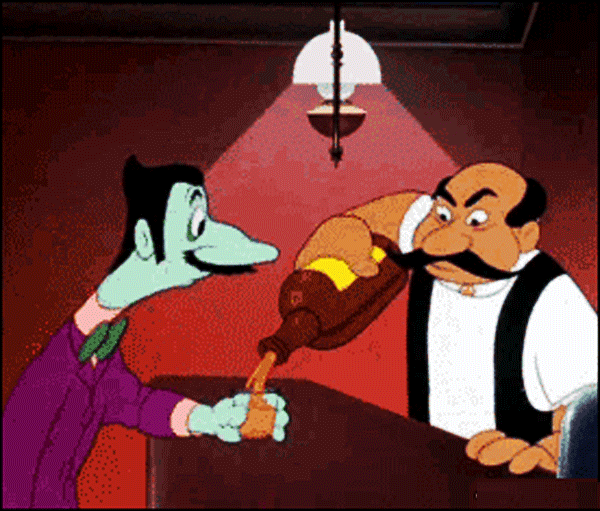
“Give Me Six Double Vodkas”
A guy came into a bar one day and said to the barman “Give me six double vodkas”.
The barman says “Wow!, you must have had one hell of a day.”
“Yes, I've just found out my older brother is gay.”
The next day the same guy came into the bar and asked for the same drinks.
When the bartender asked what the problem was today, the answer came back, “I've just found out that my younger brother is gay too!”
On the third day the guy came into the bar and ordered another six double vodkas.
The bartender says “Geez! Doesn't anybody in your family like women?”
“Yeah, my wife...”





































